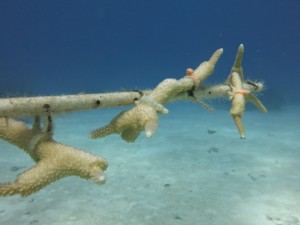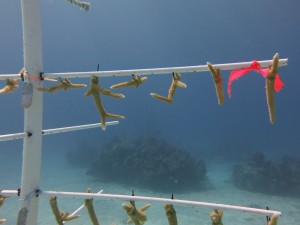In March of this year, CEI started a coral nursery in collaboration with scientists at the University of Miami RSMAS and NOAA’s Atlantic Oceanographic and Meteorological Laboratories. With their strong backgrounds in successful coral restoration, collaborating researchers were able to advise CEI on methods for staghorn collection, growth and care, and eventual outplanting. It is hoped that through these restoration efforts some of the coral cover lost in recent years around Cape Eleuthera might be recovered.

Coral bleaching is a phenomenon where corals lose their pigmentation as they expel their symbiotic algae (zooxanthellae) out of their tissues. This event occurs when corals can no longer host their symbiont due to the high energy expenses of coping with increased water temperature for extended periods of time. If a bleaching event continues for an extended period of time, corals will eventually become covered by macroalgae and die. However, the effects are reversible and zooxanthellae can return to previously vacated coral hosts.
The staghorn coral fragments on CEI’s coral tree nursery showed signs of bleaching this summer, along with some of the rest of the hard coral around Cape Eleuthera. In October, however, the tree coral regained its color and in fact continued to grow, while uncared-for corals in the area may still be struggling. This is encouraging evidence for the power of tree nurseries in coral restoration, although monthly maintenance is essential for corals’ survival.

The CEI nursery is almost ready to be expanded. This semester two additional coral trees will be installed at the same site, thereby doubling the capacity of the nursery. This will allow for coral to be re-fragmented and grown for another six months before transplantation. Stay tuned for another update on nursery expansion!